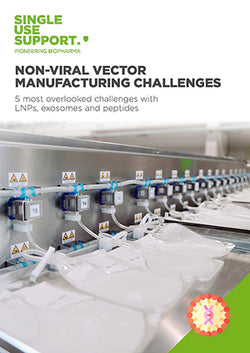Lipid nanoparticle (LNP) manufacturing: Challenges & Solutions
Lipid nanoparticles (LNPs) have gained significant attention in nanomedicine as effective delivery systems for various therapeutics, including mRNA-based vaccines and gene therapies. LNPs offer advantages such as efficient encapsulation, targeted delivery, and enhanced stability.
This article provides a step-by-step guide on how to manufacture lipid nanoparticles. Furthermore, we will take a look at general scalability and optimization considerations in LNP production.
Lipid nanoparticles
Lipid nanoparticles are self-assembled structures composed of lipids that form nanoscale particles. These vesicles consist of a lipid bilayer encapsulating a hydrophobic core, where therapeutic payloads can be embedded. LNPs in drug products serve as versatile carriers for nucleic acids (e-g- messenger RNA and oligonucleotides), peptides, and small molecules, enabling them as efficient drug delivery systems to target cells or tissues. Next to their use in applications like RNA therapeutics, LNPs have also gained attention in other fields, such as vaccine development.
LNP manufacturing: How to make lipid nanoparticles (LNPs)?
Generally speaking, LNP manufacturing steps include:
- Lipid component preparation
- Aqueous phase preparation
- Mixing
- Purification
- Concentration
- Formulation
- Fill/finish
- Quality control
Lipid component preparation
In this step, the lipid components necessary for the formation of LNPs are prepared. Lipids, which are typically a combination of different types of lipids such as phospholipids, cholesterol, cationic lipids, and other lipid derivatives, are measured and mixed together in specific ratios to achieve a lipid composition with the desired properties of the nanoparticles.
Aqueous phase preparation
The aqueous phase is prepared separately from the lipid components. This phase typically contains the active pharmaceutical ingredient (API) or other hydrophilic substances to be encapsulated within the LNPs. It may also include stabilizing agents, buffer solutions, or other ingredients necessary for the intended application.
Mixing
The lipid components and the aqueous phase are brought together and mixed. This step aims to facilitate the formation of the lipid bilayer surrounding the aqueous core, resulting in the formation of LNPs. Various mixing techniques, such as high-shear mixing or microfluidics, can be employed to achieve a uniform and stable formulation.
Purification
After mixing, the resulting mixture is subjected to purification processes to remove any impurities or unencapsulated materials. Common purification methods include ultrafiltration, centrifugation, or diafiltration. These processes help ensure the quality and purity of the final LNP product.
Concentration
Once purified, the LNPs may undergo a concentration step to increase their potency or achieve the desired concentration. This can be accomplished through various methods such as ultrafiltration or evaporation of the solvent (e.g. organic solvents), depending on the specific requirements of the formulation.
Formulation
After concentration, additional lipid nanoparticle formulation steps may be undertaken to optimize the LNPs for their intended use. This can involve adjusting the pH, adding stabilizing agents, or modifying the surface properties of the nanoparticles to enhance their morphology, stability, bioavailability, or targeted delivery.
Fill/finish
In this step, the formulated LNPs are filled into appropriate containers, such as vials or syringes, under sterile conditions. This process ensures that the LNPs remain uncontaminated and maintains their integrity until they are ready for use.
Quality control
Throughout the entire production process, assays and rigorous quality control measures are implemented. This includes testing the LNPs for various parameters, such as particle size and polydispersity, stability, drug loading efficiency, sterility, and endotoxin levels, among others.
Quality control ensures that the final product meets the required specifications and complies with regulatory standards in specific fields of application, e.g. for a subsequent synthesis to generate an mRNA-LNP.
Challenges in LNP manufacturing
The entire LNP manufacturing process demands for greatest diligence. In the following chapters, we will shed light on some aspects that require special attention.
Formulation of lipid nanoparticles
The formulation of lipid nanoparticles as non-viral vectors has revolutionized the field of drug delivery, offering promising solutions for various therapeutic applications. The selection of lipids, including phospholipids, cholesterol, and ionizable lipids, impacts the stability, encapsulation efficiency, and release kinetics of LNPs. Additionally, excipients and surfactants can be incorporated to further optimize the formulation and enhance LNP performance. [[1]]
Liposomes, solid lipid nanoparticles (SLNs) and the resulting nanostructured lipid carriers have emerged as versatile platforms and alternative to polymers, capable of encapsulating a wide range of therapeutic molecules, including mRNA vaccines and plasmids. They have gained even more attention in the course of the SARS-CoV-2 pandemic and the development of novel mRNA vaccines, exemplified by the Pfizer-BioNTech COVID-19 vaccine.
Continuous optimization of lipid nanoparticle (LNP) formulation plays a crucial role in ensuring the efficient and targeted delivery of therapeutics for both in vitro and in vivo applications. By controlling particle size and achieving a narrow size distribution, the stability, biodistribution, and cellular uptake of LNPs can be improved. And with strategies in nanotechnology like PEGylation and aqueous-based formulations, concerns such as toxicity and an optimized immune response can be addressed.
Strategies for enhancing encapsulation efficiency, such as lipid-to-drug ratio optimization and co-encapsulation approaches, are being explored to maximize therapeutic payload capacity. Surface modification techniques involving ligand or antibody conjugation enable targeted mRNA delivery, enhancing interactions with specific cells or tissues. Additionally, factors like endosomal escape, intracellular gene delivery, and mitigation of issues like aggregation, cytotoxicity, and amyloidosis are intensely discussed in LNP development. But also considerations on diffusion, dispersion, endocytosis, filtration, and incorporation influence LNP formulation optimization. [[1]]
Particle size and size distribution
Particle size and size distribution are critical parameters in LNP manufacturing. Optimization of these factors ensures the desired stability, biodistribution, and cellular uptake of LNPs. Techniques such as high-pressure homogenization, an optimized flow rate ratio, microfluidics, and nanoprecipitation can be employed to control particle size and achieve a narrow size distribution.
Encapsulation and delivery systems
LNPs provide an effective platform for the encapsulation and delivery of various therapeutics. They enable the protection of nucleic acids, peptides, or small molecules from degradation, enhance their cellular uptake, and facilitate their release at the target site. LNPs offer advantages such as controlled release, improved bioavailability, and reduced off-target effects. [[1]]
Encapsulation efficiency
Maximizing the encapsulation efficiency of LNPs is essential for effective delivery of therapeutics. It involves optimizing the lipid-to-drug ratio, utilizing co-encapsulation strategies, or employing specialized techniques such as ion complexation. Higher encapsulation efficiency ensures sufficient payload loading and improved therapeutic efficacy.
Surface modification
Surface modification of LNPs allows for targeted delivery and enhanced cellular uptake. Ligands or antibodies can be attached to the LNP surface to facilitate specific interactions with target cells or tissues. This modification enables the selective delivery of therapeutics and reduces off-target effects.
[[download-1]]
Scale-up challenges in LNP manufacturing
With lipid nanoparticles being investigated for more and more applications, the biopharma industry is facing challenges in the scale-up of manufacturing processes. Considering the very distinctive procedures involved in LNP manufacturing, measures have to be taken to ensure quality and regulatory requirements as well as process efficiency throughout and after the upscale.
Quality control and characterization
Quality control is essential to ensure the reproducibility and consistency of LNPs during scale-up. Rigorous characterization techniques such as dynamic light scattering, transmission electron microscopy, and zeta potential analysis can assess the stability, particle size, surface charge, and encapsulation efficiency of LNPs. These evaluations ensure the quality and performance of LNPs throughout the manufacturing process.
Regulatory considerations
Manufacturing LNPs for therapeutic applications requires compliance with regulatory guidelines like cGMP or GMP Annex 1. Organizations such as the FDA provide regulations and guidance to ensure the safety, quality, and efficacy of LNPs. Adhering to these regulations is vital for obtaining regulatory approval and advancing LNPs to clinical trials and commercialization.
Manufacturing methods and equipment
Scaling up the production of LNPs requires careful consideration of manufacturing methods. Techniques such as microfluidics, high-pressure homogenization, or solvent evaporation can be scaled to meet large-scale production demands while maintaining consistent LNP characteristics. Process parameters, equipment scalability, and quality control are crucial factors in the successful scale-up of LNP manufacturing.
Additionally, the manufacturing equipment, consisting of fluid management systems, freezing and thawing platforms and a variety of related consumables has to be able to adapt to production scale-up without compromising on process efficiency or safety.

Lipid nanoparticles manufacturing solutions
Single-use technologies have proven to be a viable choice to improve efficiency, cost-effectiveness and scalability in biopharma processes, as well as to bring advancements in sustainability due to a decreased need for on-site cleaning processes.
Automated processes based on single-use technologies allow for streamlined processes and reduce the risk of process irregularities, thus contributing to product quality and safety both at small and at bulk scale.
Single Use Support can provide manufacturers with cGMP-compatible platform systems for LNP processing, including solutions for homogenization, safe aliquotation and filling as well as freezing and thawing for long-term stability of LNPs. And being designed as modular systems, the solutions of Single Use Support are equally suitable for lab as well as large scale LNP production.
cGMP compatible LNP filling & aliquoting in closed systems
Filling LNPs in platform systems from Single Use Support addresses the challenges associated with LNP filling and meets all GMP relevant quality standards. The importance of filling LNPs lies in their sensitivity to contamination, which can compromise their efficacy and patient safety. By utilizing automated closed systems, the risk of contamination is minimized as manual handling and human errors are reduced. Moreover, these systems provide easy scalability, allowing for efficient production from small to large scale, catering to changing demands. Automated closed systems based on single-use technology optimize efficiency gains and streamline the LNP filling process, addressing the challenges and delivering reliable and high-quality LNPs.
Freezing LNPs - advantages of plate freezing
Freezing LNPs is particularly complex due to the need to protect their integrity and the sensitive biomaterials they carry, such as mRNA. Essential considerations during freezing include the use of cryoprotectants and managing the delicate balance of freeze-thaw cycles. Single Use Support offers innovative solutions for these challenges, particularly with their plate freezer technology. Plate freezing allows for fast and controlled freezing, enabling customization to specific temperature requirements of LNPs and the drug substances they encapsulate. This results in better preservation of LNPs, enhancing their long-term stability.
References
- Lipid-Based Nanocarriers for RNA Delivery, http://dx.doi.org/10.2174/1381612821666150531164540, Published 2015-07-16
FAQ
Are LNPs only used for mRNA-based vaccines?
+
Are LNPs only used for mRNA-based vaccines?
No, LNPs have broad applicability beyond mRNA-based vaccines. They can deliver a variety of therapeutics, including nucleic acids, peptides, small molecules, and gene therapies. For instance, Onpattro is a LNP-based siRNA drug for the treatment of polyneuropathies.
How can LNPs be targeted to specific cells or tissues?
+
How can LNPs be targeted to specific cells or tissues?
Surface modifications of LNPs with ligands or antibodies can enable targeted delivery to specific cells or tissues. These modifications facilitate receptor-mediated uptake or specific interactions with target sites.
Who produces lipid nanoparticles?
+
Who produces lipid nanoparticles?
Lipid nanoparticles (LNPs) are produced by pharmaceutical and biotech companies, as well as research institutions. These entities use LNPs for various applications, including drug delivery for treatments and vaccines, most notably mRNA vaccines such as those for COVID-19.
How are LNPs manufactured?
+
How are LNPs manufactured?
Lipid nanoparticles (LNPs) are manufactured by combining lipids, therapeutic agents, and solvents (e.g. ethanol) in a process that includes nano-precipitation, extrusion, dilution, high-pressure homogenization, or sonication. This creates nanoparticles that can encapsulate and protect the therapeutic agents, enhancing their delivery and efficacy.

Download guide
Guide: Challenges in Non Viral Vector Manufacturing
Guide about navigating 5 of the most overlooked challenges in non-viral vector manufacturing with regards to fluid management challenges, such as degradation and instability of LNP during freezing, scalability concerns in exosome manufacturing or protection against toxic solvents in peptide manufacturing.

